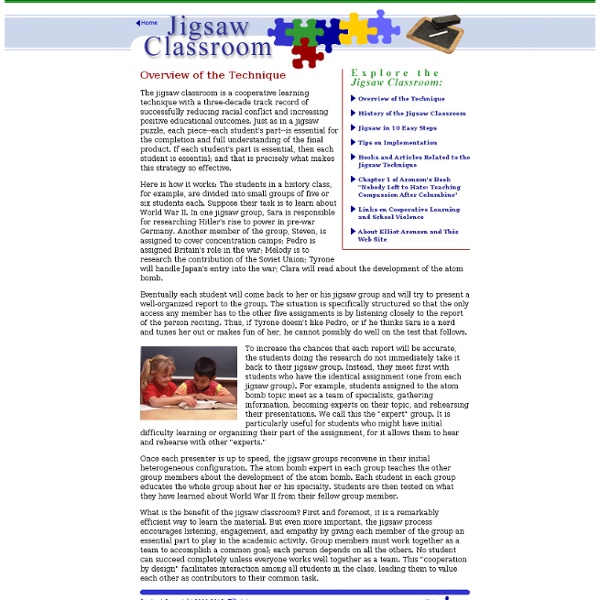The Jigsaw Classroom: Overview of the Technique

Teacher Resources and Classroom Games :: Teach This
Jigsaws
Developed by Barbara Tewksbury, Hamilton College "When efforts are structured cooperatively, there is considerable evidence that students will exert more effort to achieve - learn more, use higher-level reasoning strategies more frequently, build more complete and complex conceptual structures, and retain information learned more accurately" (Johnson and Johnson, 1999, Making Cooperative Learning Work). Over the years, the jigsaw technique has been the most popular cooperative learning strategy among faculty who have participated in On the Cutting Edge Course Design workshops. What are jigsaws? In a jigsaw, the class is divided into several teams, with each team preparing separate but related assignments. Learn more about jigsaws Why use jigsaws? The jigsaw is an effective way of engaging students both with course material and with each other. Learn more about why jigsaws are effective How to use jigsaws Learn more about how to design effective jigsaws See the Jijgsaw FAQs Examples of jigsaws
Your Pursuit
History, Thinking Processes and Communication, Level 5 This multi domain task and other presented in this section were developed by teachers for teachers. Students individually create a board game based on Trivial Pursuit (TM) in order to test the historical knowledge of an audience of Year 7 or Year 8 students. Design Guidelines Design question 1: Is the purpose of the task assessment FOR, AS or OF learning? Purpose Primary purpose: Assessment OF learning Reflection While the primary purpose of the task is assessment of learning, this task will also provide me with information about student knowledge, understanding and skills which will enable me to re-shape my learning and teaching program either for the class as a whole or for groups within the class. I have also built in a small self-assessment element which will allow for assessment as learning. Design question 2: Which domains, dimensions, standards and levels did the learning and teaching program focus on? Communication – Presenting
Printable Activities, Games, Puzzles, Worksheets & Coloring Sheets - FamilyEducation.com
'Academically Adrift'
The e5 Instructional Model
<div class='noindex'>You may be trying to access this site from a secured browser on the server. Please enable scripts and reload this page.</div> Turn on more accessible mode Skip Ribbon Commands Skip to main content Emergency Closures Teacher Support Resources The e5 Instructional Model The e5 Instructional Model was launched in 2009. r 18 months, it is a reference point for school leaders and teachers to develop a deeper understanding of what constitutes high quality teacher practice in the classroom. 1. Develops shared normsDetermines readiness for learningEstablishes learning goalsDevelops metacognitive capacity 2. Prompts inquiryStructures inquiryMaintains session momentum 3. Presents new contentDevelops language and literacyStrengthens connections 4. Facilitates substantive conversationCultivates higher order thinkingMonitors progress 5. Assesses performance against standardsFacilitates student self assessment Disclaimer
Uri Treismans Dolciani Lecture
Performance Enhanced Interactive Learning
PLTL Community
Related:
Related:



